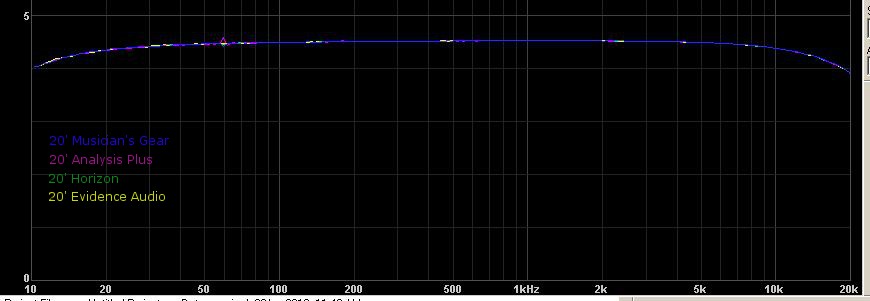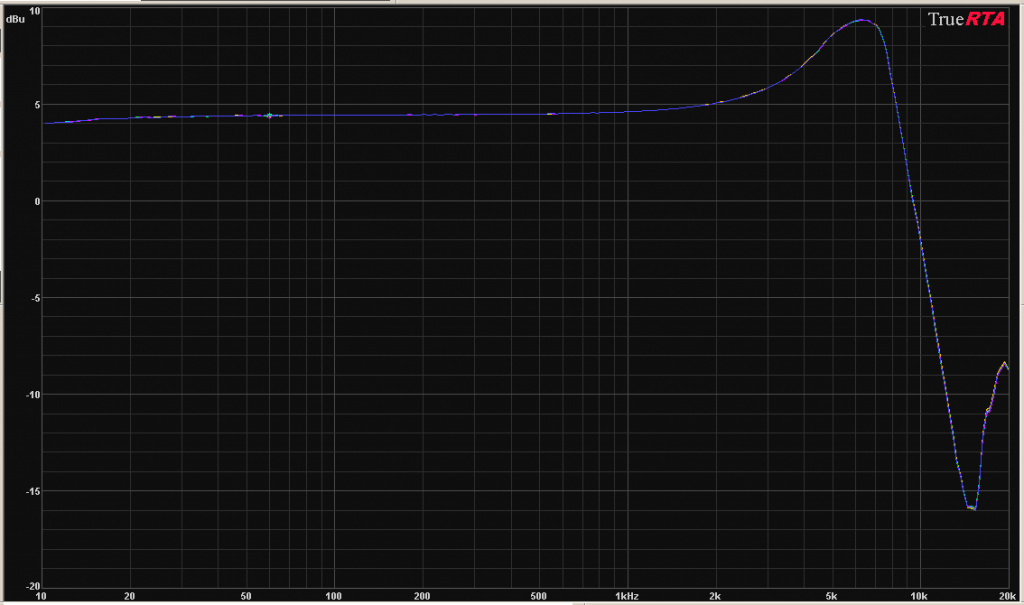We don’t typically wade into these waters, but we’ve come across some interesting information that we thought we’d share. A member of the TalkBass forum (bongomania) has spent a great deal of time testing cables, and we thought we’d summarize his findings here. His tests corroborate what we have suspected for years – that the outlandish claims that cables drastically affect tone are pure fiction.
There’s a great deal of money being made in the premium audio cable market. Monster, Mogami, Evidence, etc., etc., etc… these companies make millions of dollars selling what they claim to be a “sonically superior” cable. But are you really getting what you pay for?
First of all, let’s face facts: a cable is a passive component. It simply CANNOT add anything to your tone, period. Any company that is advertising that their cable increases bass response, clarity, or anything else is flat out distorting the truth. A cable can only reduce signal, and the only factor that comes into play when this happens is a cable’s capacitance. Capacitance is, quite simply, the ability of a body to hold an electrical charge. Typically you wouldn’t want a cable with high capacitance – it will store some of the current your instrument puts out, which will reduce the high end somewhat. Cables that claim to increase bass response are actually reducing treble response, to fool your ears into thinking you have more bass. This is similar to the effect you get when you turn your tone pot down – the guitar sounds more bassy simply by removing highs. Your guitar’s tone pot has a specific component which stores charge, which has a rather high level of capacitance, but even the cheapest guitar cable has a relatively low capacitance, which doesn’t affect your guitar’s tone in any significant way.
Now here’s the interesting part: all these expensive cables sound exactly the same as their cheaper counterparts. Here’s a graph spectrum representing the tonal characteristics of three different 15′ cables (Elixir ($60), Fender Premium Gold ($50), and Canare ($30)):

These tests were done with a constant pink noise signal. Three different colors were used, one for each cable – pink, green, and blue. As you can see, there is absolutely no audible difference between any of the cables.
Here’s another, showing the results of four 20′ cables (Musician’s Gear ($9), Analysis Plus ($159), Horizon, ($11), Evidence ($155):

Once again, the frequency analysis reveals that a $160 cable doesn’t sound any different than a $9 cable. Interestingly, the impedence (the measure of resistance to the flow of electrical current) on each of these cables was significantly different – 1 ohm on the Musician’s Gear, down to .2 ohms on the Analysis Plus. Yet they still sound exactly the same, proving once again that they only factor that can change the inherent tone of a cable is an extremely high degree of capacitance.
This proves true even when it’s not just pink noise being fed through the cable. In this test, a P-bass pickup (which is called a coil by Electrical Engineers) was run in series with the pink noise. The frequency response curve is changed, but the response from cable to cable is exactly the same (Analysis Plus Bass Oval ($155), Elixir Premium ($70), Evidence Audio Lyric HG ($159), Horizon standard ($11), Lava Magma ($25), Monster Bass ($50), Musician’s Gear standard ($9), Planet Waves Cable, Station, ($23)):

Of course, in spite of the evidence, some will still say they can hear a difference, and we’re not refuting that. What people THINK they hear is completely subjective – but that doesn’t mean what they’re hearing is accurate. The human brain is a tricky thing, and it will hear what it expects to hear, regardless of the facts. The power of suggestion is well documented, and when somebody swears they can hear a difference, well… you can see the power of advertising at work.
There’s a few other claims made by certain cable companies other than sonic differences that simply defy all logic (and the laws of physics, as well). Some say they have “time correct windings” – claiming that treble frequencies travel on the outside of the cable, and bass travels in the center. This is pure hogwash: first of all, sound is not traveling down the cable, electrical current is, and is therefore not bound by the physics of audio waveforms. Second: electrons travel at the speed of light – you really think that having “time correct windings” is going to matter when the current is traveling at the speed of light down a 15′ guitar cable? Also, gold connectors do NOT transmit electrical current any better than your standard metals used – all it does is resist corrosion. When sifting through the pseudo-scientific jargon, consider the source, and take everything you hear with a grain of salt.
Now, if you’re in the market for a cable, don’t buy into the sonic hype or any other techno-babble nonsense – buy a cable for reasons of build quality, durability, and warranty if such things matter to you.



I’m not hugely experienced in these matters but…. don’t we usually eq stuff in a mixer and or on the amp for live sound and variously when recording so as long as the the guitar cable is not completely killing the higher frequencies it does not matter that much?
Secondly. When capacitors are connected in series, the total capacitance is less than any one of the series capacitors’ individual capacitances. So if it’s really important to you to have a low capacitance cable, just take any half decent instrument cable and stick a really low value cap in series with it. Or is this too simplistic?
Before we get too technical, just blindfold yourself and see if you can tell the difference between a decent $9 cable and a $150 cable, both 15 ft long. You can’t.
Actually instead of driving it inductively, which would make still make the induction coil effwctively part of the circuit, how about eliminating the electromagnetc coupling by attaching a speaker driver physically to the strings, so that it just shakes them?
( I realize this is not exactly quantum physics here, so all this could be overkill, but to me things like mutual inductance count as spooky action at a distance.. and they can be kind of subtle anyway.)
One would need to keep the speaker far from the pickups so the only coupling is vibration. Strings should be completely damped to get rid of the standing waves, so the strings resonant frequencies don’t meddle with the input pink noise too much on the input side. Anyway its a test of the relative frequency response for different cords, so who cares about the input.
Thank you Cyrus and ScienceNazi. The rest not so much. I didnt see the full circuit on Cyrus’ link, but I am concerned that the test might still not be valid for a completely passive setup with only a guitar in the circuit. Otherwise the pink noise generator could be altering the overall frequency response. We could debate about the theory, but it would also be nice to have a test where, for example, you drive the guitar pickup inductively (using a speaker coil? not sure how else to do it), at amplitudes similar to what you get from the strings. All this should be done with the pickup in an actial guitar circuit of resistors and capacitors, setting the tone and volume all the way up. Since there is some baseline frequency response of this system the measurements are only relative, but I think thats OK here. You could divide out the baseline frequency response (measured directly without a long cable) to just compare one cable to another. Cyrus what do you think? It seems like this test would be truthier?
Very little current is flowing in the cable, since the guitar amp input impedance is 1-10 MΩ. For audio signals it’s the voltage that matters, not the current. Current could theoretically be reduced to zero and the signal would still be there, just pure voltage.
No they don’t. In wires, electrons travel at the speed of molasses. For an AC audio signal, they don’t travel down the cable at all. They sit in the same place, rocking back and forth a tiny bit, muttering to themselves.
Signals are carried by electric field waves, by the action of the electrons pushing against each other. The wave is what travels quickly down the wire, like when a stadium crowd does “the wave”.
And electromagnetic waves only travel at the speed of light in a vacuum. In a cable, the waves travel through the plastic insulator that separates the conductors, which reduces their velocity to typically 2/3 the speed of light. (Yes, your audio signals are traveling through plastic, not metal.) 😀
Correct. The reduced resistivity of a thin layer of gold is completely negligibly irrelevant in series with a 100 kΩ guitar and a 1 MΩ input impedance. Gold is better not because of its conductivity, but because it doesn’t get corroded with oxides that act like diodes and distort the signal. I’ve measured the distortion from non-gold connectors and watched the amount vary as I rotated and wiggled the connector.
Interesting stuff from all those who contributed to this subject..Some while ago our bass player/lead vocalist asked me to get her an old school curly coil cable so she could move around the stage with a bit more freedom and not trip over a long straight cable. I looked into this and ordered (at some cost) a Lava coiled cable. It arrived a few weeks later (we’re in the U.K.) and as luck would have it we had a rehearsal that very day. The cable that was used normally was a 3 Metre (10 foot) Sommer Spirit XXL with Neutrik plugs. Amp is a Aguilar Tone Hammer 500 with a pair of SL112 cabs. We plugged in our new curly lead which was thick and well put together. Oh dear me…We thought there was something wrong with the Fender bass or the amp. It sounded dead and woolly and lacked the definition and attack we were used to. After fiddling with guitar and amp I thought…Lets change back to the original cable… Hey presto.. The sound was back..Unscientific maybe, but proved to me beyond ANY doubt that the cable DOES make a difference. Sommer Spirit XXL is £2.00 a metre, so in no way an expensive cable. It does have low capacitance which is probably where the answer lies. Do I now get the bass player to go ‘radio’ ?
While I understand the point this article is trying to make, it’s representation of the facts is misleading at best.
If you actually read & understand the Ovnilab articles referenced, he makes it clear that cables regardless of price or capacitance cannot ADD frequencies, but of course capacitance will affect tone to varying degrees.
Using a high quality buffer is absolutely the most effective and logical way to “preserve” tone.
Also, many cables, including expensive ones, are noisy via interference and/or handling noise.
Getting a quality buffer, and some well constructed & shielded cables (Dimarzio, Spectraflex & Lava ELC braided are swell made & priced,) will make vastly more difference than any $200 cable could hope to do, as well as being more versatile.
I assume all these cables were tested brand new. Which really doesn’t mean anything, because how many of us play on brand new cables on a regular basis?
Put each of these cables through 3 years worth of gigging and then test them. The cheapos won’t even work at that point, let alone give you a signal. That’s where the monetary difference comes from.
TYPO here https://sfguitarworks.com/the-great-cable-myth/
“anything else is flat our [out?] distorting the truth”
Great article, thanks.
Robert Hale
Mesa AZ
From my experience, only very long cables can affect tone. After 20 ft, you lose some treble response and good quality components can make a difference. More than that, a buffer can correct the signal loss. So if you have great cables and no buffer, you may end up worse than standard cables with a buffer. The rest is a matter of choice, but I would ban cheap cables/contacts/jacks, mainly because they inevitably will be the source of humming, buzzing and signal loss and break in the long run.
I am so glad I posted here. Every few weeks I get a notification of another comment.
Watching you all argue over proven science as if your opinion somehow can change what is factual has been hilarious.
Once you’re done wasting your time go read some books and you will soon agree;
Cables affect tone.
Hi guys,
A friend of mine just linked me to this thread–I’m “bongomania”. Just for reference, I fully intend to continue refining and challenging my own test methods, so this project will continue to evolve. I do plan to do the impulse tests Alex K suggested–in fact I just bought a new digital scope just for that purpose.
Here’s the take-away point that I really hope people will get: It’s 100% true that cable capacitance affects tone, and 100% false that quality or price has anything to do with capacitance. I really do have $9 cables that transmit the highs better than most $150 cables.
My current recommendation is that people buy the most rugged, well-made, yet flexible cables they can find; the capacitance should be around 10-20 pF/ft if you like a bright tone, or between 30 and 40 pF/ft if you like a “warm” tone.
I’m totally open to questions, challenges, requests, criticisms, etc. You can reach me on Talkbass or TGP, or email me via my site. Also for more “fun” reading, go to TGP and search for a big recent thread about Sommer cables, as well as a thread titled “does anyone believe that polishing the wire improves the signal speed”. 🙂
Whew – I’m better now.
Oh, I was only exasperated because I had just read the entire thread, which was actually pretty painful, not because of anything published by sfguitarworks.com.
I’d characterize the final results as anything but “slight” though. I beg of you to look at BongoMania’s graph again:
http://www.ovnilab.com/4gs/CableTest2.jpg
THAT is quite objective, now that Bongo’s got his test rig set up more like a passive bass pickup. What we see here is a 10db peak at the resonance peak – the filter pole of the entire modeled pickup-cable-amp signal chain. As we change cables, it’s shifting anywhere from 1.5khz to 4.5 khz. This is HUGE! it’s a mid-sweep parametric-EQ. Using different cables, the resonance peak is shifting almost TWO OCTAVES!
Anyway, we don’t really need the experiments or even the formulas to show us this – this is all readily audible, and hearing is everything, isn’t it? I do completely agree with you that burning money on cables is kind of crazy: a low or a high resonance peak can be a key ingredient to one’s tone – for richer or for poorer. Case in point: Jimi Hendrix, on the same songs, used to use a long cable for some sounds and then a shorter cable for others.
A final note: there’s a component in every passive-pickup equipped guitar and bass that can do %90 of what a $129 cable does do to the resonance peak: swap the pots for different values, for a cost of about $1.29 each. For the frugal, experimentation with 29 cent resistors is recommended.
Thanks for your response. No reason to be exasperated, Dave – Bongo made a bunch of revisions long after we posted this, and we haven’t been able to post a followup yet. Still, the final verdict shows that the differences in cables is only affected by capacitance – which we stated, and which is patently obvious. Even in Bongo’s final chart, the differences between cables is fairly slight, and certainly doesn’t warrant spending hundreds of dollars on a boutique cable.
We’ll try to post a followup blog as soon as we’re able.
HELLO?
I don’t think a lot of you even read through the thread. It was VERY difficult to plow through. At least BongoMania did.. Here’s Bongo’s site with his FINAL conclusion: http://www.ovnilab.com/articles/cables.shtml . These results VERY different than the preliminary graphs posted here – where BongoMania first started out with no idea what he was doing, simply hooking up different instrument cables from his sound card output to his sound card input.
Good on BongoMongo for going the distance in relentlessly pursuit of refining his understanding and technique.
Maybe SFGuitarWorks.com should post a redaction?
For reference: http://en.wikipedia.org/wiki/RC_circuit
exasperated,
Dave
This is pretty interesting. To really put any debate to rest, it would be great to see a series of impulse responses taken from each cable. I don’t expect that we would see any differences, but it would quantitatively demonstrate that cables are very similar in both the time and frequency domains.
Great article! However, what can you tell me about how cable length affects tone?
Hi. Nit-pick: electrons travel, on average, at a rather slow drift velocity in between scattering events. In between scatterings, their speed is the Fermi velocity, which for copper is about 1/200’th the speed of light.
http://en.wikipedia.org/wiki/Drift_velocity
Excellent article. Thank you for dispelling these myths. I think so many people WANT to believe that some gadget or component will improve their sound. This has almost become a science vs. religion type of an argument. Information like this will (hopefully) save people some money.
thanks for this. excellent report. I’ve sort of been waiting to see something like this on an oscilloscope.
One more test i’d like to see is a sine or sawtooth wave in a high freq pickup test, though I assume the P-bass pickup (10kohms?) would be the same roughly as a 5kohm single coil, rather than a pink noise test.
Here’s why:
The thing about the comparison to a potentiometer is correct, but it is the combination of the capacitor and the (added) resistance that changes the waveform of the signal, limiting high frequencies. So in this case, the amount of capacitance combined with a constant resistance would change the resulting waveform. You won’t see this potentially as a frequency response graph, nor necessarily within 20-20khz. As Rupert Neve proved with mixing boards, even though our hearing range is this, we perceive higher frequencies as coloration of the range we do hear.
A wave signal with high harmonic content (square, sawtooth) will be altered by a combination of capacitance and resistance, and it will change it by limiting frequency in the high end, changing the actual waveform.
Can you do that sort of test?